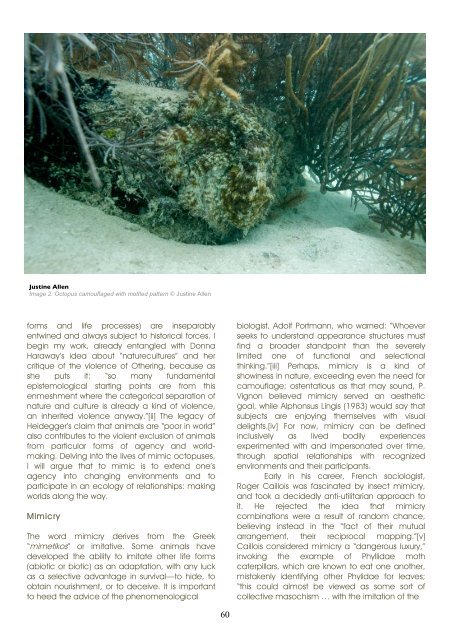Animal Influence I - Antennae The Journal of Nature in Visual Culture
Animal Influence I - Antennae The Journal of Nature in Visual Culture
Animal Influence I - Antennae The Journal of Nature in Visual Culture
Create successful ePaper yourself
Turn your PDF publications into a flip-book with our unique Google optimized e-Paper software.
Just<strong>in</strong>e Allen<br />
Image 2: Octopus camouflaged with mottled pattern Just<strong>in</strong>e Allen<br />
forms and life processes) are <strong>in</strong>separably<br />
entw<strong>in</strong>ed and always subject to historical forces. I<br />
beg<strong>in</strong> my work, already entangled with Donna<br />
Haraway’s idea about “naturecultures” and her<br />
critique <strong>of</strong> the violence <strong>of</strong> Other<strong>in</strong>g, because as<br />
she puts it: “so many fundamental<br />
epistemological start<strong>in</strong>g po<strong>in</strong>ts are from this<br />
enmeshment where the categorical separation <strong>of</strong><br />
nature and culture is already a k<strong>in</strong>d <strong>of</strong> violence,<br />
an <strong>in</strong>herited violence anyway.”[ii] <strong>The</strong> legacy <strong>of</strong><br />
Heidegger’s claim that animals are “poor <strong>in</strong> world”<br />
also contributes to the violent exclusion <strong>of</strong> animals<br />
from particular forms <strong>of</strong> agency and worldmak<strong>in</strong>g.<br />
Delv<strong>in</strong>g <strong>in</strong>to the lives <strong>of</strong> mimic octopuses,<br />
I will argue that to mimic is to extend one’s<br />
agency <strong>in</strong>to chang<strong>in</strong>g environments and to<br />
participate <strong>in</strong> an ecology <strong>of</strong> relationships: mak<strong>in</strong>g<br />
worlds along the way.<br />
Mimicry<br />
<strong>The</strong> word mimicry derives from the Greek<br />
“mimetikos” or imitative. Some animals have<br />
developed the ability to imitate other life forms<br />
(abiotic or biotic) as an adaptation, with any luck<br />
as a selective advantage <strong>in</strong> survival—to hide, to<br />
obta<strong>in</strong> nourishment, or to deceive. It is important<br />
to heed the advice <strong>of</strong> the phenomenological<br />
60<br />
biologist, Adolf Portmann, who warned: “Whoever<br />
seeks to understand appearance structures must<br />
f<strong>in</strong>d a broader standpo<strong>in</strong>t than the severely<br />
limited one <strong>of</strong> functional and selectional<br />
th<strong>in</strong>k<strong>in</strong>g.”[iii] Perhaps, mimicry is a k<strong>in</strong>d <strong>of</strong><br />
show<strong>in</strong>ess <strong>in</strong> nature, exceed<strong>in</strong>g even the need for<br />
camouflage; ostentatious as that may sound, P.<br />
Vignon believed mimicry served an aesthetic<br />
goal, while Alphonsus L<strong>in</strong>gis (1983) would say that<br />
subjects are enjoy<strong>in</strong>g themselves with visual<br />
delights.[iv] For now, mimicry can be def<strong>in</strong>ed<br />
<strong>in</strong>clusively as lived bodily experiences<br />
experimented with and impersonated over time,<br />
through spatial relationships with recognized<br />
environments and their participants.<br />
Early <strong>in</strong> his career, French sociologist,<br />
Roger Caillois was fasc<strong>in</strong>ated by <strong>in</strong>sect mimicry,<br />
and took a decidedly anti-utilitarian approach to<br />
it. He rejected the idea that mimicry<br />
comb<strong>in</strong>ations were a result <strong>of</strong> random chance,<br />
believ<strong>in</strong>g <strong>in</strong>stead <strong>in</strong> the “fact <strong>of</strong> their mutual<br />
arrangement, their reciprocal mapp<strong>in</strong>g.”[v]<br />
Caillois considered mimicry a “dangerous luxury,”<br />
<strong>in</strong>vok<strong>in</strong>g the example <strong>of</strong> Phyllidae moth<br />
caterpillars, which are known to eat one another,<br />
mistakenly identify<strong>in</strong>g other Phylidae for leaves;<br />
“this could almost be viewed as some sort <strong>of</strong><br />
collective masochism … with the imitation <strong>of</strong> the












